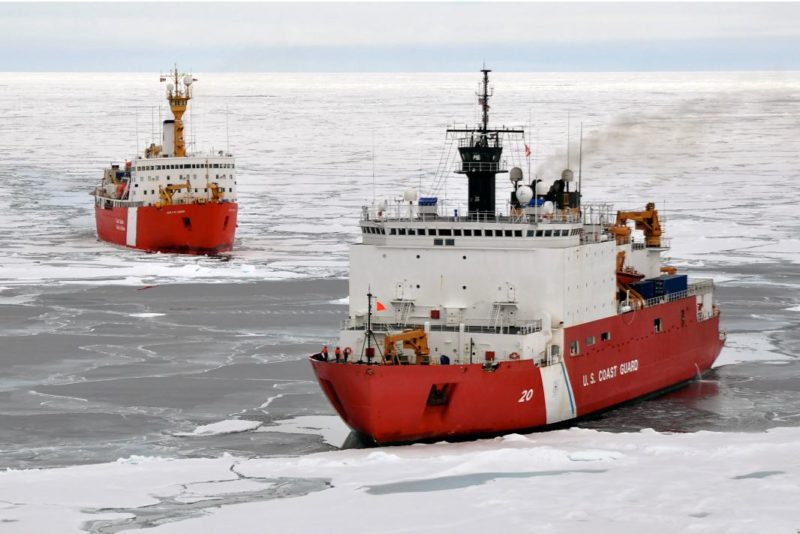International competition in the Arctic is increasing to levels not seen since the Cold War, driven by both geopolitical change and the region’s shifting climate, according to a new Coast Guard plan for protecting U.S. interests in the high north.
With a nearly $746 million contract in hand for its first heavy icebreaker in 40 years, the Coast Guard this week outlined how it wants to assert the U.S. and allied nations’ influence. The strategic plan calls for preferring cooperation over competition. It clearly identifies rivals as Russia, with its longstanding commercial and military establishments in the Arctic, but also China as a new player claiming ‘near-Arctic’ status with interests in trade routes and resources.
“China, a non-Arctic state, continues to expand its influence and seeks to gain strategic advantage around the world. China has challenged international law in the East and South China Seas, built islands, and claimed territorial status to suit its national interests,” the report notes. “China’s pattern of behavior in the Indo-Pacific region and its disregard for international law are cause for concern as its economic and scientific presence in the Arctic grows.”
China is seeking to extend its ‘Silk Road’ plan for new commercial and strategic positions into the Arctic with “construction of a second multi-mission ice-capable ship, the announcement that it will construct a nuclear-powered icebreaker, annual deployments of research vessels into the Arctic, and investments in vulnerable communities,” the report says. “China’s attempts to expand its influence could impede U.S. access and freedom of navigation in the Arctic as similar attempts have been made to impede U.S. access to the South China Sea.”
The Coast Guard’s long drive to recapitalize its icebreaking capability took a major step forward this week with the award of $745.9 million contract to VT Halter Marine Inc., Pascagoula, Miss., for the first polar security cutter — the preferred program name, adopted by Coast Guard advocates to stress the challenges now faced as nations press into the Arctic seas.
The full program could be worth $1.9 billion with the exercise of options to build two additional PSCs, replacements for the 399’x83’6”x31’ Polar Star, the last of two heavy icebreakers built in the mid-1970s.
Canada, Denmark and Norway have made new investments in ice-capable patrol ships, as the U.S. lagged in rebuilding its polar fleet. Meanwhile, changing climate is driving the new strategic competition, the report says.
“The warming of the Arctic has led to longer and larger windows of reduced ice conditions. In 2018, Arctic sea ice remained younger and thinner, and it covered less area than in the past. The twelve lowest summer minimums in Arctic ice extents in the satellite record have occurred in the last 12 years,” the report notes.
“The near-term future of Arctic shipping routes is uncertain, but in optimal conditions they are significantly shorter compared to transits via the Straits of Malacca and the Suez Canal. For example, the Northern Sea Route (NSR) offers a 35-day mean transit time from Shanghai to Rotterdam, shaving two weeks off the Suez/Malacca transit route. Commercial shipping through the Arctic is growing, including a doubling of cargo tonnage transported on the NSR with significant shipments of natural gas and oil products from the Yamal LNG terminal in Russia.
“The number of cruise ships, ranging in capacity from 150 to 1,700 passengers, transiting the Arctic continues to rise dramatically, from 120 per year in 2008 to 290 in 2016. Commercial vessel traffic through the region will continue to grow. These routes require access through the relatively narrow and shallow Bering Strait, increasing the risk of a grounding or collision during peacetime and of the strait becoming a strategic choke point during times of conflict.”
The report stresses difficulties of operating in the Arctic, climate change notwithstanding. For example, the closest Coast Guard air station in Kodiak, Alaska, is still 820 miles south of the North Slope borough of Utqiagvik – about the same distance between Boston and Miami on the East Coast.
Despite apprehension over the future with China and Russia, the Coast Guard plan envisions a multilateral, cooperative future in the Arctic, noting the service’s traditionally productive relationships with its Canadian, Russian and other counterparts.
“U.S. interests are best served by working with the eight Arctic Nations to ensure common interests, such as maritime safety, environmental stewardship, and sovereignty. The Coast Guard will partner with the Arctic nations, as well as partners and allies with Arctic interests, to keep the Arctic a conflict-free region where international law and respect for sovereignty are upheld,” the report states.




